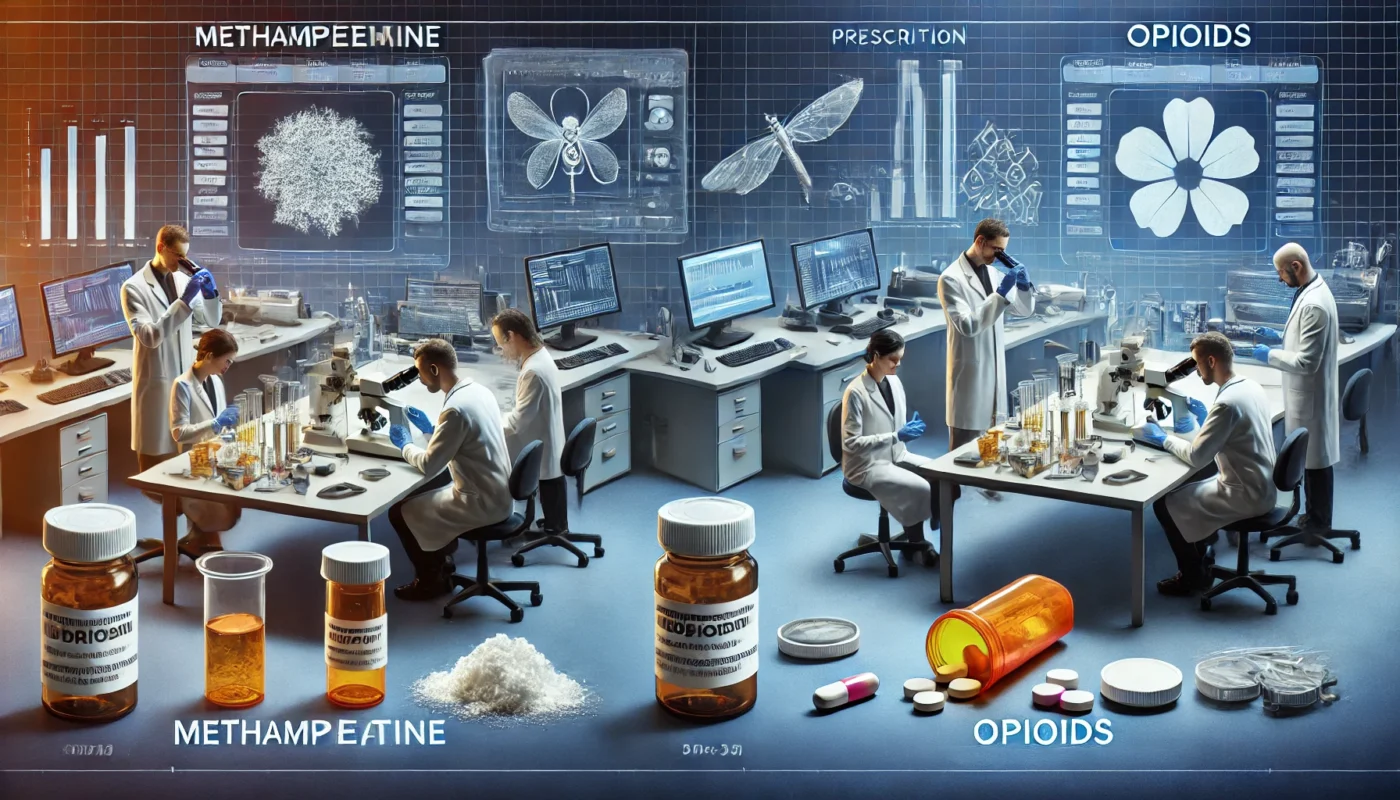In today’s fast-paced world, understanding the nuances between various substances is crucial for making informed health and wellness decisions. Methamphetamine (commonly known as meth) and opioids are two classes of drugs that, despite their potential for misuse, serve different purposes and affect the body in distinct ways. This article aims to dissect these differences and provide a comprehensive understanding of meth vs. opioids.
You may also like: Understanding Long-Term Pain Relief Options
What is Methamphetamine?
Methamphetamine, often abbreviated as meth, is a powerful central nervous system stimulant. It’s chemically similar to amphetamine, a drug used to treat ADHD and narcolepsy. Meth is known for its potency and high potential for abuse and addiction.
The Chemistry Behind Methamphetamine
Methamphetamine is a synthetic drug that alters the chemical balance of the brain. Its structure allows it to cross the blood-brain barrier rapidly, leading to intense and immediate effects. This rapid onset is one reason for its high abuse potential. Meth is often manufactured illegally using over-the-counter medications and toxic chemicals, which can result in impure and dangerous products.
Short-Term Effects of Methamphetamine Use
The immediate effects of meth use include increased physical activity, decreased appetite, and heightened wakefulness. These effects can last from a few hours to a full day, depending on the dose and purity of the drug. Users may also experience an increased heart rate, increased blood pressure, and hyperthermia, which can lead to severe health complications if not managed.
Long-Term Consequences of Methamphetamine Use
Chronic meth use can lead to profound physical and psychological issues. Long-term users often suffer from severe dental problems, commonly known as “meth mouth,” due to dry mouth and poor oral hygiene. Additionally, users may develop skin sores from repeated scratching, as well as significant weight loss. Mentally, chronic meth use can lead to anxiety, confusion, insomnia, and even violent behavior.

How Methamphetamine Works
Meth increases the release and blocks the reuptake of the neurotransmitter dopamine, leading to high levels of this chemical in the brain. This is what gives meth its characteristic euphoric effects. Users often experience increased energy, alertness, and a sense of well-being. However, these effects come at a significant cost, as meth use can lead to severe dental problems, skin sores, and a host of other health issues.
Is Meth an Opioid?
A common question is whether methamphetamine is an opioid. The answer is no. Meth is a stimulant, whereas opioids are depressants. They work on different pathways in the brain and produce very different effects.
What are Opioids?
Opioids are a class of drugs that include both prescription pain relievers and illegal drugs like heroin. Prescription opioids include medications such as oxycodone, hydrocodone, and morphine, which are often prescribed for their effective pain-relieving properties.
The Science of Opioids
Opioids work primarily by binding to specific receptors in the brain and other parts of the body. These receptors are part of the brain’s reward system and play a key role in controlling pain and emotion. By activating these receptors, opioids not only relieve pain but also produce feelings of pleasure and satisfaction, which can lead to misuse.
Medical Uses of Opioids
In the medical field, opioids are invaluable for managing both acute and chronic pain. They are often prescribed after surgeries, for severe injury pain, or for palliative care in cancer patients. However, their use must be carefully monitored to avoid the risk of addiction, as even prescribed use can lead to dependency.
Opioid Addiction and the Brain
Chronic use of opioids can lead to physical dependence and addiction. The brain becomes accustomed to the presence of opioids and requires them to function normally. Withdrawal symptoms can be severe and include pain, nausea, vomiting, and mood disturbances. This dependence makes it difficult for users to quit without professional help.
How Opioids Work
Opioids work by binding to opioid receptors in the brain, spinal cord, and other areas of the body. They block pain signals sent from the body to the brain and release large amounts of dopamine throughout the body. This not only reduces the perception of pain but also creates a sense of euphoria.
Is Methamphetamine a Narcotic?
The term “narcotic” is often used interchangeably with opioids, but in the legal and law enforcement contexts, it can sometimes refer to any illegal drug. Meth is not a narcotic in the traditional sense, as it does not have the pain-relieving properties typical of opioids.
Key Differences Between Meth and Opioids
Mechanism of Action
- Methamphetamine is a stimulant that increases dopamine levels, leading to increased energy and alertness.
- Opioids are depressants that block pain signals and increase dopamine levels, leading to pain relief and euphoria.
Differences in Neurotransmitter Effects
Methamphetamine primarily affects dopamine pathways, leading to increased energy and euphoria. In contrast, opioids primarily act on opioid receptors, affecting pain perception and emotional responses. These fundamental differences in action mean they have different applications and risks.
Impact on Brain Function
Meth use can lead to neurotoxicity, which can damage brain cells and alter brain chemistry permanently. Opioid use, while not directly neurotoxic, can lead to changes in brain structure and function due to prolonged exposure and dependency. Both substances significantly alter how the brain processes rewards and pain.
Effects on the Body
- Meth use can lead to severe physical side effects, including dental issues (“meth mouth”), weight loss, and skin sores.
- Opioid use is associated with drowsiness, constipation, and can lead to respiratory depression, which is often the cause of overdose deaths.
Physical Health Risks
Long-term meth use can result in severe physical health issues such as cardiovascular problems and malnutrition. On the other hand, opioids can cause chronic constipation and hormonal imbalances. Both substances carry a risk of overdose, but opioids are particularly lethal due to their effect on the respiratory system.
Psychological and Behavioral Effects
While meth users may experience paranoia, hallucinations, and aggressive behavior, opioid users may suffer from depression and anxiety. Meth can lead to erratic and unpredictable behavior, whereas opioids often result in lethargy and withdrawal from social activities.
Addiction and Withdrawal
Both meth and opioids have high potential for addiction, but the withdrawal symptoms and treatment protocols differ significantly. Meth withdrawal is primarily psychological, while opioid withdrawal can include severe physical symptoms.
Methamphetamine Withdrawal Symptoms
Meth withdrawal often involves severe fatigue, depression, and increased appetite. Users may also experience cravings and anhedonia, which is the inability to feel pleasure. These symptoms can last for weeks, making recovery challenging without professional support.

Opioid Withdrawal Symptoms
Opioid withdrawal is notoriously difficult, with symptoms such as muscle aches, restlessness, insomnia, and gastrointestinal distress. These symptoms can begin within hours of the last dose and may require medically supervised detoxification to manage effectively.
Treatment Approaches
Treatment for meth addiction often focuses on behavioral therapies and support groups. In contrast, opioid addiction treatment may involve medication-assisted treatment (MAT) with drugs such as methadone or buprenorphine, alongside counseling and support. Both require comprehensive, long-term treatment plans.
The Dangers of Misidentification
Misunderstanding the differences between meth and opioids can lead to improper treatment and prevention strategies. For instance, opioid antagonists like naloxone can reverse opioid overdoses but have no effect on meth overdoses. This highlights the importance of accurate substance identification in medical settings.
Implications for Healthcare Providers
Healthcare providers must be able to distinguish between meth and opioid use to provide appropriate care. Misdiagnosis can lead to ineffective treatment plans and increased health risks. Training and education are essential for healthcare workers to recognize the symptoms and effects of each substance accurately.
Public Health Concerns
Public health campaigns must address the unique challenges posed by meth and opioids. These substances require different prevention and intervention strategies due to their distinct effects and risks. Misinformation can contribute to stigma and hinder effective public health responses.
Legal and Policy Considerations
Legal systems need to differentiate between meth and opioids when considering drug-related offenses. Policies should reflect the different risks and treatment needs associated with each substance. Proper classification is necessary to ensure that resources are allocated effectively and that users receive appropriate support.
Practical Advice for Health Enthusiasts and Patients
For Fitness Enthusiasts
Understanding the effects of these substances can aid in making informed decisions about health and wellness. Avoiding illicit drug use is crucial for maintaining optimal physical and mental health.
Maintaining a Drug-Free Lifestyle
Fitness enthusiasts should focus on natural ways to boost energy and performance. Regular exercise, a balanced diet, and adequate sleep can enhance well-being without the risks associated with drug use. Awareness and education about the dangers of meth and opioids can empower individuals to make healthier choices.
Impact on Athletic Performance
Drug use can severely impact athletic performance and recovery. Meth can lead to muscle breakdown and cardiovascular issues, while opioids can impair coordination and reaction times. Understanding these risks is essential for athletes committed to long-term health and success.

For Health Enthusiasts
Stay informed about the substances that can impact health, both positively and negatively. This knowledge can help in advocating for oneself in medical settings and when engaging in holistic health practices.
Educating Yourself and Others
Being informed about the effects of meth and opioids can help in making sound health decisions. Sharing this knowledge with friends and family can promote awareness and prevention. Staying updated with reliable sources ensures that your understanding remains accurate and relevant.
Integrating Holistic Practices
Incorporating holistic health practices can support overall well-being and reduce the reliance on medications. Techniques such as meditation, yoga, and herbal remedies can complement traditional medical treatments, offering a balanced approach to health care.
For Medical Patients
If you are prescribed opioids for pain management, use them only as directed by a healthcare provider. Be aware of the signs of addiction and seek help if needed. Meth should never be used recreationally, as its effects can be devastating and long-lasting.
Safe Opioid Use
Patients prescribed opioids should follow their healthcare provider’s instructions carefully to minimize the risk of addiction. Keeping open communication with your doctor can help in managing pain effectively while monitoring for any signs of dependency. Never share your medication with others, as misuse can be dangerous.
Seeking Help and Support
If addiction becomes a concern, seeking professional help immediately is crucial. Support groups and counseling can provide the necessary guidance and encouragement for recovery. Early intervention increases the likelihood of successful treatment and long-term well-being.
Conclusion
Understanding the differences between methamphetamine and opioids is critical for anyone interested in health and wellness, from fitness enthusiasts to medical patients. By distinguishing these substances, we can make better health decisions, seek appropriate treatment, and engage in effective prevention strategies. This knowledge empowers us to approach health holistically, integrating both traditional and alternative methods for optimal well-being.
Empowering Informed Decisions
Knowledge about meth and opioids enables individuals to make informed choices about their health and lifestyle. By understanding these substances, we can take proactive steps to protect ourselves and our communities from their dangers. Education and awareness are key components in promoting a healthier society.
Building a Supportive Community
Communities can play a pivotal role in addressing substance misuse by fostering an environment of support and understanding. Encouraging open dialogue and reducing stigma can help individuals seek help without fear of judgment. Collective efforts can lead to more effective prevention and treatment strategies.
Looking Ahead
The ongoing challenges posed by meth and opioids require continued attention and action. By staying informed and engaged, we can contribute to a future where these substances pose less of a threat to public health. Collaborative efforts between individuals, healthcare providers, and policymakers are essential to achieving this goal.
Further Reading:
Drugs of Abuse: Distinguishing Meth, Heroin, and Xanax
Methamphetamine, Cocaine, and Stimulants
healthcare, substance abuse, methamphetamine, opioids, public health, addiction, prevention strategies, fitness, holistic health, drug-free lifestyle, athletic performance, patient education, support groups, community awareness, health decisions, mental health
Important Note: The information contained in this article is for general informational purposes only, and should not be construed as health or medical advice, nor is it intended to diagnose, prevent, treat, or cure any disease or health condition. Before embarking on any diet, fitness regimen, or program of nutritional supplementation, it is advisable to consult your healthcare professional in order to determine its safety and probable efficacy in terms of your individual state of health.
Regarding Nutritional Supplements Or Other Non-Prescription Health Products: If any nutritional supplements or other non-prescription health products are mentioned in the foregoing article, any claims or statements made about them have not been evaluated by the U.S. Food and Drug Administration, and such nutritional supplements or other health products are not intended to diagnose, treat, cure, or prevent any disease.

